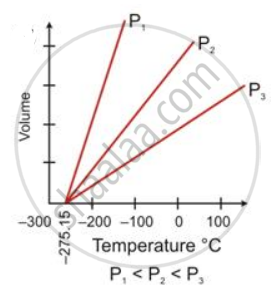Advertisements
Advertisements
प्रश्न
It is required to reduce the volume of a gas by 20% by compressing it at a constant pressure. To do so, the gas has to be cooled. If the gas attains a final temperature of 157°C, find the initial temperature of the gas.
उत्तर
Initial conditions:
V1 = Initial volume of the gas = V
T1 = Initial temperature of the gas = ?
Final conditions:
V2 (Final volume) = reduce by 20%
= V - `20/100` of V
= `(80"V")/100`
= `(4"V")/5`
T2 = Final temperature of the gas = 157°C = 157 + 273 = 430 K
By Charles Law:
`"V"_1/"T"_1 = "V"_2/"T"_2`
Substituting the values:
`"V"/"T"_1 = ((4"V")/5)/430`
`1/"T"_1 = 4/(5 xx 430)`
T1 = `(430 xx 5)/4`
T1 = 537.5 K
Therefore, final temperature of the gas = 537.5 K - 273 K = 264.5°C
APPEARS IN
संबंधित प्रश्न
Explain Charles's law on the basis of the kinetic theory of matter.
State the law which is represented by the following graph:

Give reasons for the following:
Mountaineers carry oxygen cylinders with them.
State the following:
Ice point in absolute temperature
Choose the correct answer:
The absolute temperature value that corresponds to 27°C is
Choose the correct answer:
The volume-temperature relationship is given by
88 cm3 of nitrogen is at a pressure of 770 mm mercury. If the pressure is raised to 880 mmHg, find by how much the volume will diminish, the temperature remaining constant.
Calculate the final volume of a gas 'X' if the original pressure of the gas at STP is doubled and its temperature is increased three times.
State Charles's law.
At a given temperature the pressure of a gas reduces to 75% of its initial value and the volume increases by 40% of its initial value. Find this temperature if the initial temperature was -10°C.
